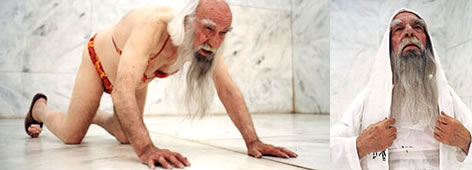|
|


Tuesday, June 22 & Wednesday, June 23 at
9 pm
Zagreb Youth Theatre, Teslina 7
SOCIETAS RAFFAELLO SANZIO CESENA,
ITALY
BR. #04 Bruxelles - Brussel, Tragedia
Endogonidia
Societas Raffaello Sanzio, that is nowaday's one of the
world's definitively leading theatre companies, was founded in 1981
in Cesena by a group of young uncompromising artists who, after education
in the arts and sciences, entered into theatre, video and film, and
more specifically plastic and written meditation. The beginning of
their work can be defined as an iconoclastic theatre which distances
itself from traditional scene setting and inclines towards a more
inventive poetic of non-figurative energy, both powerful and refined
at the same time, relating sacral, mostly Byzantine iconography,
within natural spaces and elements.
The group aesthetic, supported by the rich diversity of the talents of their
members, is related to a nostalgic appeal which simultaneously leads towards
ritual violence and sacredness: a space of considerable dramaturgic splits
in which a sense of depth becomes an intelligible participant presents something
exceptionally disturbing and unique in the contemporary theatre scene.
Their last universal successes include the performances Giulio
Cesare, Genesi
from the Museum of Sleep, Voyage au bout de la nuit and Il
Combattimento. All
are guided by relations that direct to uncertain possibilities of presentation
which are exposed as topos of contradiction and symbolization through the role
of an inherent witness. This witness is the spectator; in each of their realizations
s/he witnesses an inexplicable, inexorable spreading of symbolic and experimental
power.
2004 marks the fourth visit of Societas Raffaello Sanzio to Eurokaz. After
they introduced themselves to Zagreb’s audience in 1989 with the show Saint
Sofia and I'm Aware Of Hatred You Nurture For Me and Gilgamesh in 1991, they
presented Masoch in 1993. This year they are coming with the fourth Brussels
episode of the cycle Tragedia Endogonidia.
The cycle Tragedia Endogonidia started in January 2002 in Cesena, Italy, the
hometown of Societas Raffallo Sanzio and director Romeo
Castellucci, that is
in a way a Bayreuth of contemporary Italian theatre. This dramatic cycle that
has been developed in eleven separate episodes linked to ten European cities,
will end in October 2004 with its final eleventh episode in Cesena, the same
place where it begun. The Brussels KunstenFESTIVALdesArts produced the fourth
episode of the tragic, after Avignon and Berlin, and before Bergen, Paris,
Rome, Strasbourg, London and Marseilles.
Tragedy is obscure, but the obscurity of humans doesn’t come from an academic
contemplation of the tragic, but rather from an intrapersonal cognition /com/prehen/sion
of the body that maintains absolute power over the individual. Tragedy doesn’t
recall religious phantasms and there is not death in her nucleus but the scandal
of birth. The birthplace of tragedy is at the spot where the experience of
the world falls apart, from the level of contemplation to the problem of scientific
axiology.
Tragedia Endogonidia is conceived as an open presentation, constantly changing
its directions during three production years and showing different levels of
development that delay its end. The fourth Brussels episode, that will be presented
in Zagreb this year, introduces new figures in its schedule of displaced humanity.
These characters are linked to the theme of duration by teasing the enigma
of beginning, birth, initiating language and being swallowed by the abyss of
time. In the white marble decoration of the hall lit with six neon lights,
Castellucci builds the show on a double axis: human bodies in their evolution
- alive and elevated against bodies divided by past and imposed frames of law
and language.
Castellucci’s cycle deals with different tragic parameters in each episode
- chorus, sacrificial lamb, protagonists, fire, time… With the return of figures,
the themes are adapted to different angles, the axis are determined approximately;
the show creates rows of specific allusions. But here there is no death of
the hero, nothing that generates resolution or calm.
The cycle is presented as an inventive process without shades or ellipses.
It’s a dramatic system with a strong component of development, and episodes
represent degrees of change. Tragedy is created without chorus or his comments
and insights; it refers to those simple living beings that with their gonads
unceasingly follow a direction of fearless immortality.
http://www.raffaellosanzio.org/
|
|






